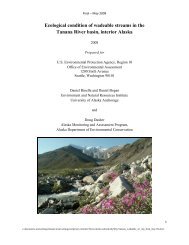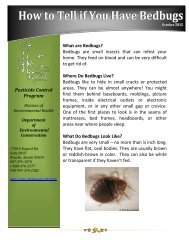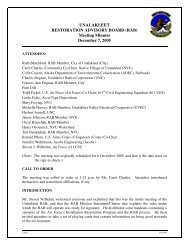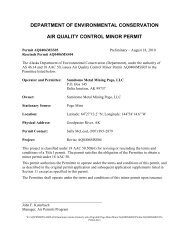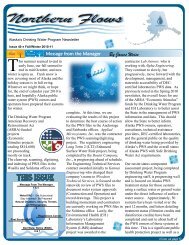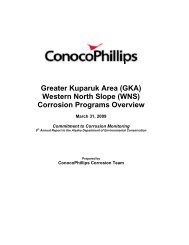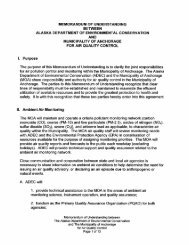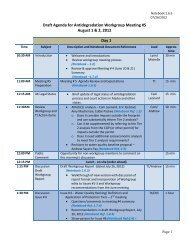2012 Ocean Ranger Guidebook Revision 3-7-12 - Alaska ...
2012 Ocean Ranger Guidebook Revision 3-7-12 - Alaska ...
2012 Ocean Ranger Guidebook Revision 3-7-12 - Alaska ...
Create successful ePaper yourself
Turn your PDF publications into a flip-book with our unique Google optimized e-Paper software.
<strong>20<strong>12</strong></strong> <strong>Ocean</strong> <strong>Ranger</strong> <strong>Guidebook</strong> 3-7-<strong>12</strong><br />
Background: OWS oil content metering should be functional with the set parameters (calibrations).<br />
What to check for: If multiple oil content meters installed the meter should give similar reading over the<br />
same sample flow. Calibration records should include the oil content meter checks and findings<br />
including the calibration actions and ranges. Recording s monitoring results of the readings?<br />
Job Aid Item: 7.2.d<br />
Text: Ensure sample analyzed by OWS meter is OWS output (trace sample line for presence of<br />
unacceptable clean water connection) (33 CFR 155.370(a)) (33 CFR 151.10)<br />
Background: OWS treated flow should be the flow which is used for “compliance” measured oil content.<br />
What to check for: The treated flow outlet from OWS to the discharge is sampled (representative) by<br />
the OWS oil content meter. Piping in place to the meter. Alarm monitor readings during operation of the<br />
OWS?<br />
Job Aid Item: 7.2.e<br />
Text: Check for oil dispersants use in oil tanks or lubrication systems (40 CFR 110.4 & EPA VGP 2.2.9)<br />
Background: Oil dispersants could remove a sheen, when oil is still being discharged to waters. Some<br />
emulsifiers could be used to cause oil or grease to sink instead of float, which reduces the likelihood of<br />
an oil loss being detected. It also creates more difficult conditions for clean-up.<br />
What to check for: Check for dispersants added to oil tanks or lubrication systems such as shaft seals.<br />
Check when tanks are filled. Check for possible “chemical” dosing systems. Not to be confused with the<br />
cleaning system of the OWS itself.<br />
Citations:<br />
40 CFR 110.4 Dispersants.<br />
Addition of dispersants or emulsifiers to oil to be discharged that would circumvent the provisions of<br />
this part is prohibited.<br />
EPA VGP 2.2.9 Controllable Pitch Propeller and Thruster Hydraulic Fluid and other Oil to Sea Interfaces including Lubrication<br />
Discharges from Paddle Wheel Propulsion, Stern Tubes, Thruster Bearings, Stabilizers, Rudder Bearings, Azimuth Thrusters,<br />
Propulsion Pod Lubrication, and Wire Rope and Mechanical Equipment Subject to Immersion.<br />
The protective seals on controllable pitch propellers, azimuth thrusters, propulsion pods, rudder bearings, or any<br />
other oil to sea interfaces must be maintained in good operating order to minimize the leaking of hydraulic oil or other oils. The<br />
vessel owner/operator must not discharge oil in quantities that may be harmful as defined in 40 CFR Part 110 from any oil to<br />
sea interface. If possible, maintenance activities on controllable pitch propellers, thrusters and other oil-to-sea interfaces<br />
should be conducted when a vessel is in drydock.<br />
Minimize maintenance activities on stern tube seals when a vessel is outside of drydock. If maintenance or emergency<br />
repair must occur on stern tubes or other oil-to sea interfaces which have a potential to release oil in quantities that may be<br />
harmful as defined in 40 CFR Part 110, appropriate spill response resources (e.g. oil booms) must be used to contain any oil<br />
leakage. Operators of the vessel must have ready access to any spill response resources to clean any potential oil spills.<br />
After applying lubrication to wire rope and mechanical equipment subject to immersion, wire ropes and other<br />
equipment must be thoroughly wiped down to remove excess lubricant.<br />
Owner/operators should use an environmentally preferable lubricant, including vegetable oil, synthetic ester, or<br />
polyalkylene glycol as a base for these applications when feasible. Use of an environmentally preferable lubricant does not<br />
authorize the discharge of any lubricant in a quantity that may be harmful as defined in 40 CFR Part 110.<br />
210






